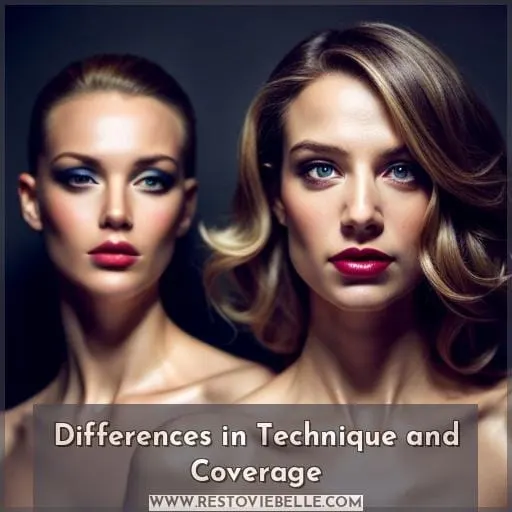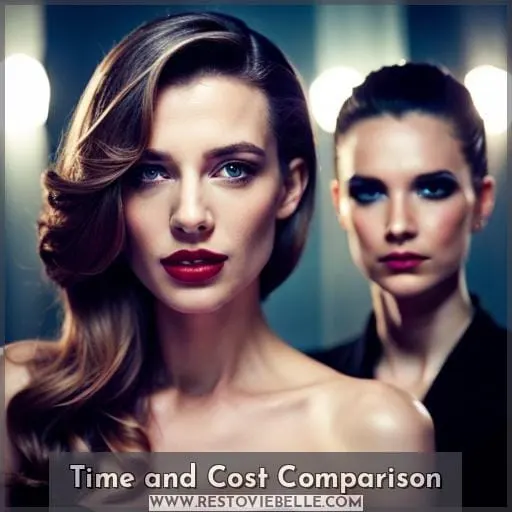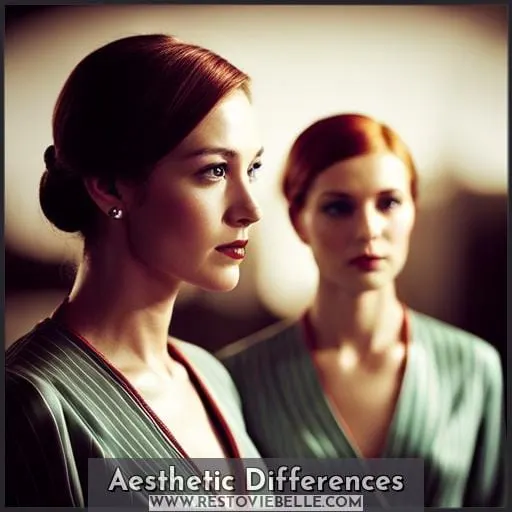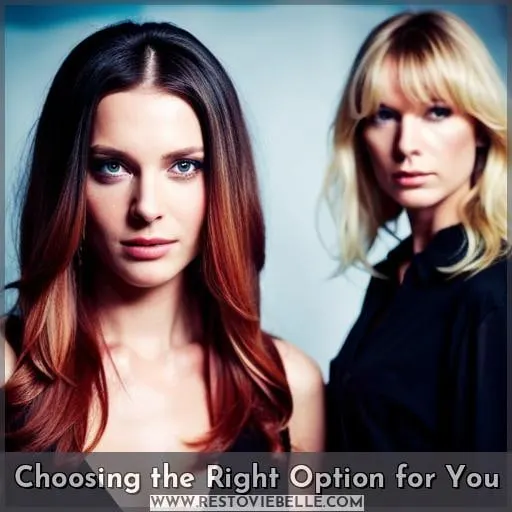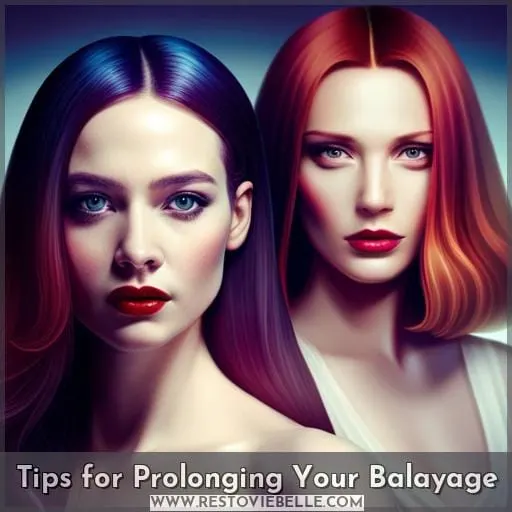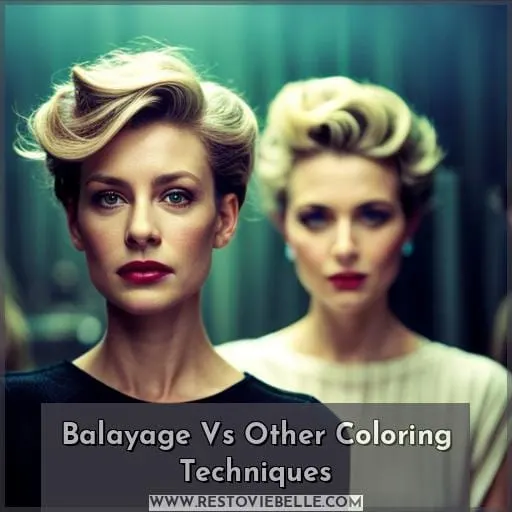This site is supported by our readers. We may earn a commission, at no cost to you, if you purchase through links.
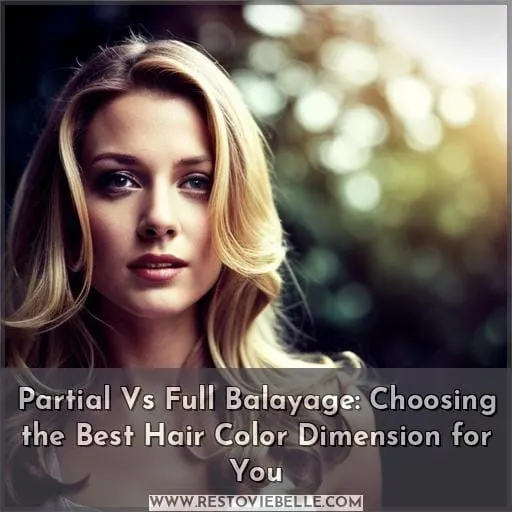 Like a chameleon changing colors, balayage transforms your locks with subtle or dramatic dimensions.
Like a chameleon changing colors, balayage transforms your locks with subtle or dramatic dimensions.
Craving sandy strands or spicy red hues without full commitment? Partial balayage spotlights sections, keeping lengths low-key.
Seeking a sultry overhaul? Full balayage completely reworks tresses for maximum impact.
Cost, upkeep and your desired look dictate what’s best. Talk options with your colorist and unlock dimension that empowers.
Table Of Contents
- Key Takeaways
- Partial Balayage Vs Full Balayage
- Differences in Technique and Coverage
- Time and Cost Comparison
- Aesthetic Differences
- Upkeep and Maintenance
- Choosing the Right Option for You
- Tips for Prolonging Your Balayage
- Balayage Vs Other Coloring Techniques
- Frequently Asked Questions (FAQs)
- How often do I need to get my roots touched up with partial balayage?
- Can I go swimming or exercise right after getting partial balayage?
- Is there a difference in how the balayage looks on curly vs straight hair?
- What happens if I don’t like my partial balayage – can it be fixed?
- Do I need any special hair products to maintain my partial balayage?
- Conclusion
Key Takeaways
- Partial balayage offers subtle, natural-looking highlights focused on the ends and top layers for a nuanced effect. Full balayage provides all-over bold, dramatic dimension with striking color variation.
- Partial balayage costs $100-$200, takes around 1 hour, and requires less frequent touch-ups for maintenance. Full balayage runs $300-$500, takes over 3 hours, and needs more regular upkeep.
- The partial balayage technique involves selective, precise application for a targeted look. The full balayage technique covers the whole head through precision painting for an all-over transformation.
- Partial balayage creates versatility for styling and is great for those seeking a subtle change. Full balayage makes a bold, eye-catching statement advantageous for dramatic changes.
Partial Balayage Vs Full Balayage
When choosing between partial balayage and full balayage, it’s important to understand the definitions of each technique.
Partial balayage focuses on specific sections of your hair, typically targeting the top layer with an emphasis on the ends.
On the other hand, full balayage covers your entire head and involves bleaching all of your hair while leaving out only the roots.
Understanding these distinctions will help you make an informed decision about which option is best for achieving your desired look.
Definition of Partial Balayage
When opting for partial balayage, you’re highlighting only certain sections of your hair rather than doing a full head application.
Known as Sectional Elegance, partial balayage focuses the Brushstroke Beauty on the ends through End-Focused Highlights.
This allows for a Soft Contrast and Painterly Perfection without the commitment of full balayage in cost, salon visits, and upkeep.
Definition of Full Balayage
You’re looking at more complete coverage with full balayage since it involves bleaching and highlighting the entire head of hair rather than just sections.
Full balayage offers a dramatic transformation, providing versatility in highlights throughout your locks.
The detailed application process ensures a precise and customized result.
While partial balayage may be more cost-effective, choosing between full and partial balayage ultimately depends on your desired look and commitment level.
Keep in mind that full balayage generally comes with a higher price tag compared to its partial counterpart.
Differences in Technique and Coverage
When it comes to balayage, you have two main options: partial or full.
Partial balayage involves highlighting specific sections of your hair, usually focusing on the top layers and ends, while full balayage covers your whole head for a more dramatic, all-over effect.
The technique and coverage area differ between the two, so weigh your preferences for subtlety vs.
Partial Balayage Focuses on Specific Sections of Hair
Its focus on specific sections of hair makes partial balayage a more subtle option than full balayage’s complete head coverage.
Here are key aspects of partial balayage’s selective approach:
- Targets face-framing pieces or crown for dimension
- Allows natural hair to show through sections
- Gives lighter touch around edges for a brightening effect
- Uses balayage handpainting for natural yet striking results
Full Balayage Covers the Entire Head
Your entire head is covered in full balayage, differing from partial balayage’s targeted sections. Full balayage offers a complete transformation with head-to-toe radiance through precision painting.
| Full Balayage | Partial Balayage |
|---|---|
| Entire Head | Focused Sections |
| Dramatic Dimension | Subtle Highlights |
| Balayage Application | Placement Planning |
Time and Cost Comparison
When deciding between partial and full balayage, you’ll want to weigh the time and cost considerations.
A partial balayage is generally quicker, taking about an hour, while a full can require over 3 hours from start to finish.
You’ll also save on cost with a partial, typically ranging from $100-$200, whereas a full balayage can set you back $300-$500.
Partial Balayage Takes Less Time to Complete
A partial balayage’s briefer session makes it the more time-efficient option. With quick application and a streamlined salon process, you can save both time and money compared to a full balayage.
The shorter processing time means you’ll be out of the chair sooner, allowing for greater flexibility in appointment booking.
Additionally, partial balayage offers low maintenance and styling options that suit your busy lifestyle while still delivering beautiful dimension to your hair.
Full Balayage is Usually More Expensive
Full balayage typically costs more than partial balayage and takes longer to complete.
With full head coverage, you can expect to pay $300-500 for the initial process plus frequent touch-ups.
The dramatic, all-over dimension comes at a price.
When budgeting for a blondor freelights transformation, factor stylist time, product use, and maintenance into cost considerations alongside the desire for a striking style statement.
Aesthetic Differences
When deciding between subtlety and drama, consider the aesthetic contrasts between partial and full balayage.
While partial balayage provides a more subtle look, full balayage makes a bold statement, creating an eye-catching, dimensional blonde effect across all layers.
The choice comes down to whether you prefer a subtle sun-kissed glow or a striking, dazzling transformation.
Partial Balayage Provides a More Subtle Look
Frequently, you’re opting for a more subtle look with partial balayage.
By concentrating colorful dimensions solely on the face or ends, styling options stay versatile across seasons.
Strategic color blending and face-framing highlights better suit those desiring natural-looking lightening.
With partial balayage, hair texture and roots stay predominantly untouched for a delicate sun-kissed finish.
Full Balayage Creates a More Dramatic Effect
To achieve a more striking and bold hair transformation, opt for full balayage as it creates a dramatic effect throughout your entire head of hair.
- Styling options: Full balayage offers limitless styling possibilities with its all-over color variation.
- Color variation: Full balayage allows for greater color contrast and dimension choices, resulting in an eye-catching look.
- Application tips: When applying full balayage, consider the underlying pigment to achieve desired lightened colors by adjusting the hair developer accordingly.
Upkeep and Maintenance
When it comes to maintaining your balayaged locks, partial balayage will require less upkeep with fewer touch-ups needed.
Full balayage may demand appointments every 10 to 12 weeks for root smudging and toning to keep regrowth blending seamlessly.
Opt for partial balayage if you’re seeking a lower maintenance look or have a busy schedule.
Partial Balayage Requires Less Upkeep
Keeping your highlights fresh, partial balayage needs less maintenance as new growth is less visible over time. With fewer sections lightened, blending regrowth and preventing obvious roots becomes simpler.
| Goal | Tips | Benefit |
|---|---|---|
| Minimize washing | Use dry shampoo | Preserves color longevity |
| Refresh color | Use purple shampoo | Tones brassiness |
| Maintain moisture | Deep condition regularly | Restores hair health |
Careful styling and smart techniques prolong your dimensional partial balayage.
Full Balayage May Need Touch-ups More Frequently
Yet with full balayage, you’re looking at more frequent touch-ups every 12-14 weeks to maintain the look.
- Color transition requires careful root blending
- Partial highlights help ease end maintenance
- Gradual transformation needs disciplined toner use
- Purple shampoo counters brassiness between salon visits
- Balayage causes less damage than foiled highlights
Choosing the Right Option for You
When deciding between subtle dimension with partial balayage or dramatic transformation with full coverage, consider your budget, maintenance tolerance, and how much of a change you want. Both options differ in cost, upkeep needs, and the intensity of color dimension achieved, so weigh your hair goals and lifestyle factors.
Are you seeking a subtle, natural look or a head-turning balayage makeover?
Partial vs Full Coverage
When deciding between partial and full balayage coverage, you can tailor your choice to achieve the desired hair color dimension.
- Opt for partial balayage to blend your natural color with subtle highlights.
- Opt for full balayage for dramatic, all-over dimension.
Consider face-framing highlights, styling versatility, color blending capabilities, and sun exposure when determining highlight placement.
Transition smoothly between looks with high-quality products.
Subtle vs Dramatic Look
Your choice between partial balayage’s subtle look or full balayage’s dramatic dimension depends on your personal preferences for hair color and upkeep.
Partial balayage allows for customizable highlights and accents to frame your face.
Full balayage enables bold, seamless color blending and easier transitions between seasons.
Consider both subtle and dramatic styling variations when deciding between dimension levels.
Cost and Upkeep
One more thing to consider when choosing between partial and full balayage is cost and upkeep—full balayage is usually more expensive and requires more frequent touch-ups to maintain vibrant color and regrowth blending.
However, dimension-boosting tricks like versatile styling, subtle color transitions, and professional hair care tips can extend your investment in brilliant balayaged locks.
Regular hydrating hair masks, heat protection, and gentle cleansing maintain dazzling color between appointments.
Tips for Prolonging Your Balayage
Tips help extend your balayage’s lifespan through gentle hair care.
- Limit washing to 1-2 times per week and use cold water to preserve color.
- Air dry instead of heat styling when possible and use a heat protectant if blowdrying.
- Deep condition weekly and avoid chlorine to maintain hair health.
- In summer, shield hair from sun exposure with protective styles or hats.
Seeking professional advice on proper at-home care between appointments helps keep your balayage vibrant. Using products like Blondor Seal + Care after washing neutralizes pH levels for optimal color retention.
With some thoughtful hair TLC, you can prolong that fresh-from-the-salon balayaged look.
Balayage Vs Other Coloring Techniques
Now that you understand how to prolong your balayaged locks, let’s explore how this technique compares to other popular coloring methods.
While highlights and ombre remain prevalent, balayage stands out for its artistry and customization. A balayage blends tones across the color spectrum for a striking yet natural look that flatters various hair textures.
The key difference lies in the stylist’s technique. They paint the highlights freehand instead of using foils, offering greater dimension. This specialized approach makes balayage highlights appear soft and seamless, almost as if kissed by the sun.
The result is a lightweight and low-maintenance color that endures for months with proper care for hair liberation.
| Coloring Method | Application Method | Maintenance Needs | Longevity |
|---|---|---|---|
| Highlights | Foils | Medium | Medium |
| Ombre | Solid lower section | Low | Extended |
| Balayage | Freehand/Painted | Low | Extended |
Frequently Asked Questions (FAQs)
How often do I need to get my roots touched up with partial balayage?
With partial balayage, you’ll likely only need root touch-ups every 3-4 months since it highlights specific sections rather than your whole head. Focusing on the ends and top layers means new growth blends relatively seamlessly.
Still, regular toner gloss treatments keep your color fresh between appointments.
Can I go swimming or exercise right after getting partial balayage?
I would gently advise waiting 24-48 hours before swimming or intense exercise, as the chemicals may initially irritate your scalp.
Is there a difference in how the balayage looks on curly vs straight hair?
On curly hair, partial balayage adds dimension through accentuating curls with lighter pieces throughout. The variation creates more contrast compared to straight hair, where blended highlights softly frame the face.
What happens if I don’t like my partial balayage – can it be fixed?
Unfortunately, yes. If you don’t like your partial balayage, it can be adjusted.
A skilled colorist can tweak the tones or placement to achieve your desired look.
Be honest with your stylist about what you want changed – good communication is key.
With some coloring finesse, your hair goals can become reality.
Do I need any special hair products to maintain my partial balayage?
Yes, use sulfate-free shampoo and conditioner to prolong vibrancy.
Also use a purple shampoo once a week to neutralize brassy tones.
Apply a heat protectant before hot tools.
Minimize washing and sun exposure.
This routine maintains the dimension of your partial balayage.
Conclusion
Whether you seek sandy strands or a sultry overhaul, balayage unlocks dimension to empower your mane.
Let your inner flame’s whispers guide you towards subtle spotlights or dramatic reworks. Both revive hair magic; partial keeps lengths low-key while full completely transforms.
Talk options with your colorist – together map out the route towards your best self’s expression.
